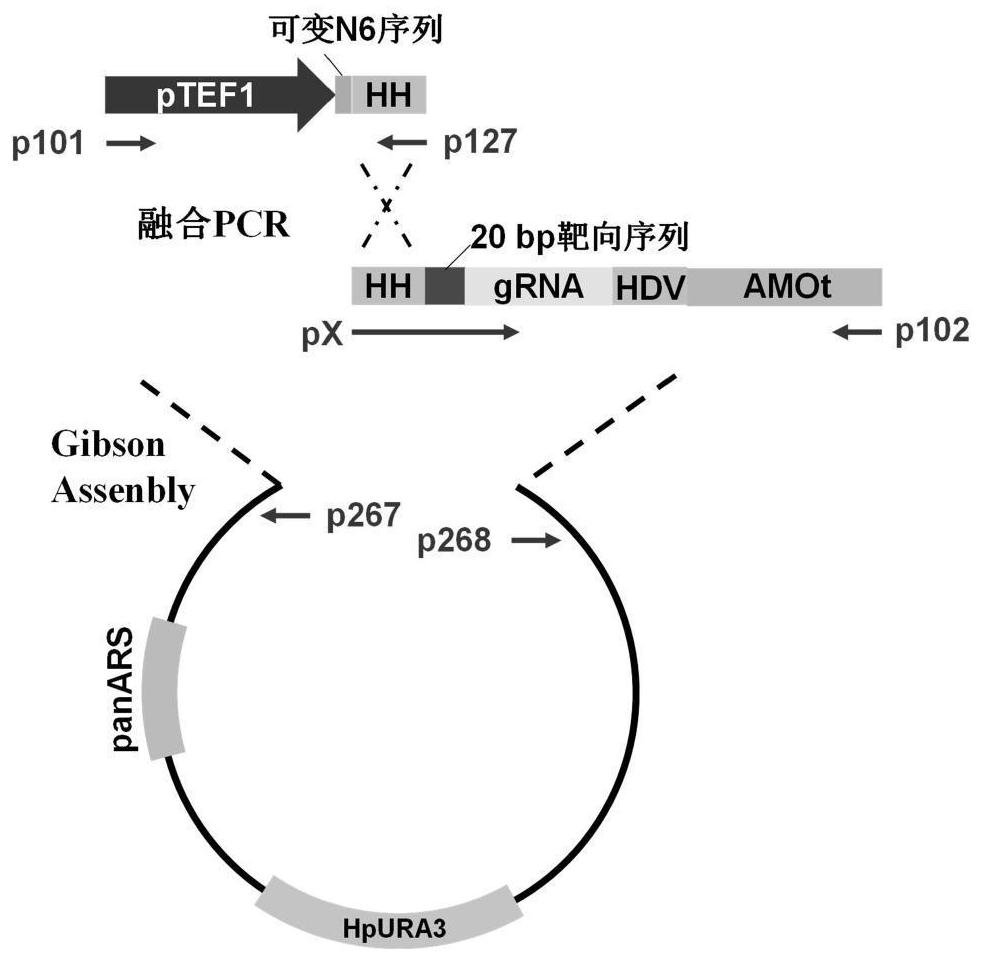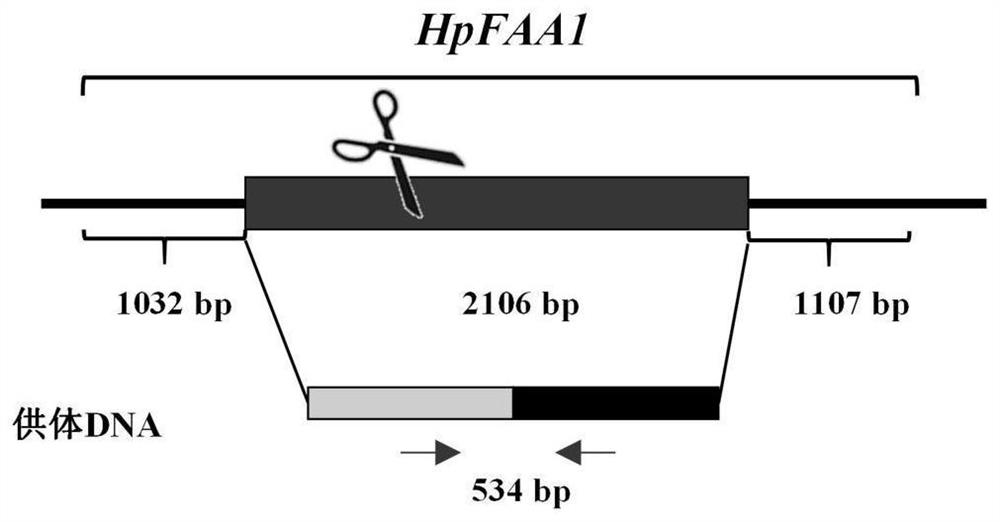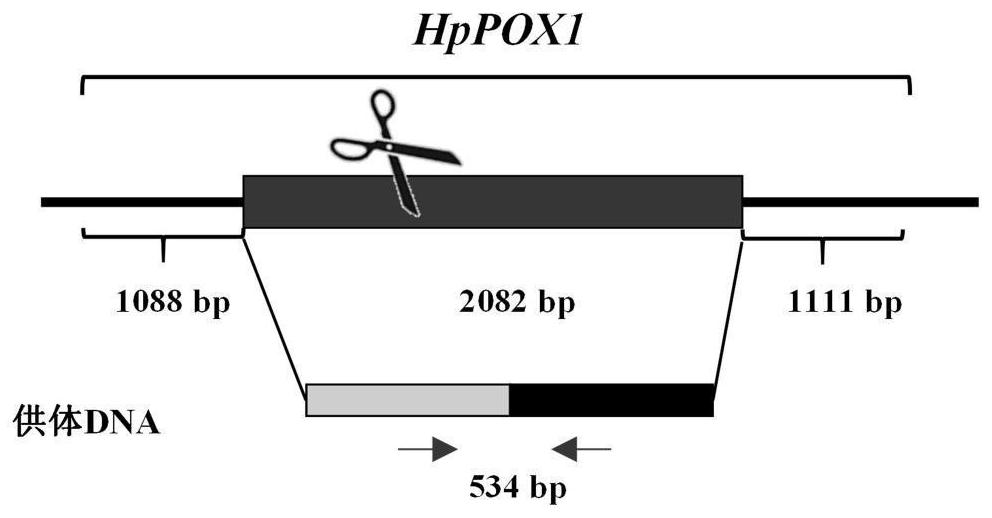Construction method and application of recombinant hansenula polymorpha
A technology of Hansenula polymorpha and a construction method is applied in the field of construction of recombinant Hansenula polymorpha to achieve the effects of increasing accumulation and improving fatty acid production
- Summary
- Abstract
- Description
- Claims
- Application Information
AI Technical Summary
Problems solved by technology
Method used
Image
Examples
Embodiment 1
[0063] Construction of High Fatty Acid Yield Hansenula Strains
[0064] (1) Construction of gene editing CRISPR / Cas9 system
[0065]The starting strain, Ogataeapolymorpha NCYC 495leu1.1, was purchased from China General Microorganism Culture Collection Center (CGMCC 2.2412). In the early stage, the laboratory independently constructed the recombinant Hansenula 495-3 (genotype MATa, leu1.1, pGAP-hCAS9-AOX1t) integrating the CAS9 gene, and used this as the host strain to construct high-yield fatty acid and derivative strains. Wherein, the concrete construction method of bacterial strain 495-3 is as follows: first, with primer pGAP-Fw-EcoRI (CGCCGC gaattc TTTTTGTAGAAATGTCTTGG) and pGAP-Rv-XhoI (CCGTCGctcgagTGTGTTTTGATAGTTGTTCA) amplified the pGAP promoter derived from Pichia pastoris, and the vectors pPICZ A and pGAP were digested and ligated with EcoR I and Xho I, respectively, to obtain the recombinant vector pPICZA-pGAP. Amplify the human CAS9 gene (primer Cas9-Fw-SacII: AT...
Embodiment 2
[0072] Recombinant Hansenula fatty acid fermentation
[0073] (1) culture medium
[0074] YPD medium: 20g / L glucose, 20g / L peptone, 10g / L yeast powder;
[0075] SD medium: 20g / L glucose, 6.7g / L YNB, supplemented with essential amino acid components when necessary;
[0076] Fermentation medium (basic component medium): (NH 4 ) 2 SO 4 2.5g / L, KH 2 PO 4 14.4g / L, MgSO 4 ·7H 2 O0.5g / L, add about 900mL ddH 2 O, adjust the pH to 5.6, dilute to 950mL, and sterilize at 115°C for 30min. After sterilization, add 1mL vitamin solution and 2mL trace metal solution, and add essential amino acids when using. Add different kinds of carbon sources to the fermentation medium, including 20g / L glucose, 10g / L methanol and 20g / L xylose, etc., for fatty acid fermentation.
[0077] (2) Experimental process and conditions
[0078] For strain activation, pick 3 single colonies and place them in 3 / 15mL YPD medium or SD medium, and culture them with shaking at 220rpm at 37°C for 24h; Transf...
Embodiment 3
[0087] Effect of NADPH Supply on Fatty Acid Synthesis
[0088] The production process of fatty acids consumes NADPH extremely. When glucose is used as the substrate, although cells can rely on the pentose phosphate pathway to provide NADPH, the supply may still be insufficient. Therefore, we additionally introduced other NADPH supply pathways, including overexpressing the cytoplasmic isocitrate dehydrogenase ScIDP2 gene, and knocking out the succinyl-CoA synthetase OpLSC2 gene ( image 3 ).
[0089] (1) Overexpression of isocitrate dehydrogenase 2 (ScIDP2)
[0090] Citrate or isocitrate in the cytoplasm will form α-ketoglutarate under the catalysis of isocitrate dehydrogenase Idp2p, accompanied by the generation of NADPH ( image 3 ). Therefore, overexpression of ScIDP2 gene is a commonly used strategy to increase intracellular NADPH supply. However, there is no cytoplasmic ScIDP2 gene in Hansenula, and we first considered overexpressing the ScIDP2 gene from Saccharomyces ce...
PUM
 Login to View More
Login to View More Abstract
Description
Claims
Application Information
 Login to View More
Login to View More - R&D
- Intellectual Property
- Life Sciences
- Materials
- Tech Scout
- Unparalleled Data Quality
- Higher Quality Content
- 60% Fewer Hallucinations
Browse by: Latest US Patents, China's latest patents, Technical Efficacy Thesaurus, Application Domain, Technology Topic, Popular Technical Reports.
© 2025 PatSnap. All rights reserved.Legal|Privacy policy|Modern Slavery Act Transparency Statement|Sitemap|About US| Contact US: help@patsnap.com



